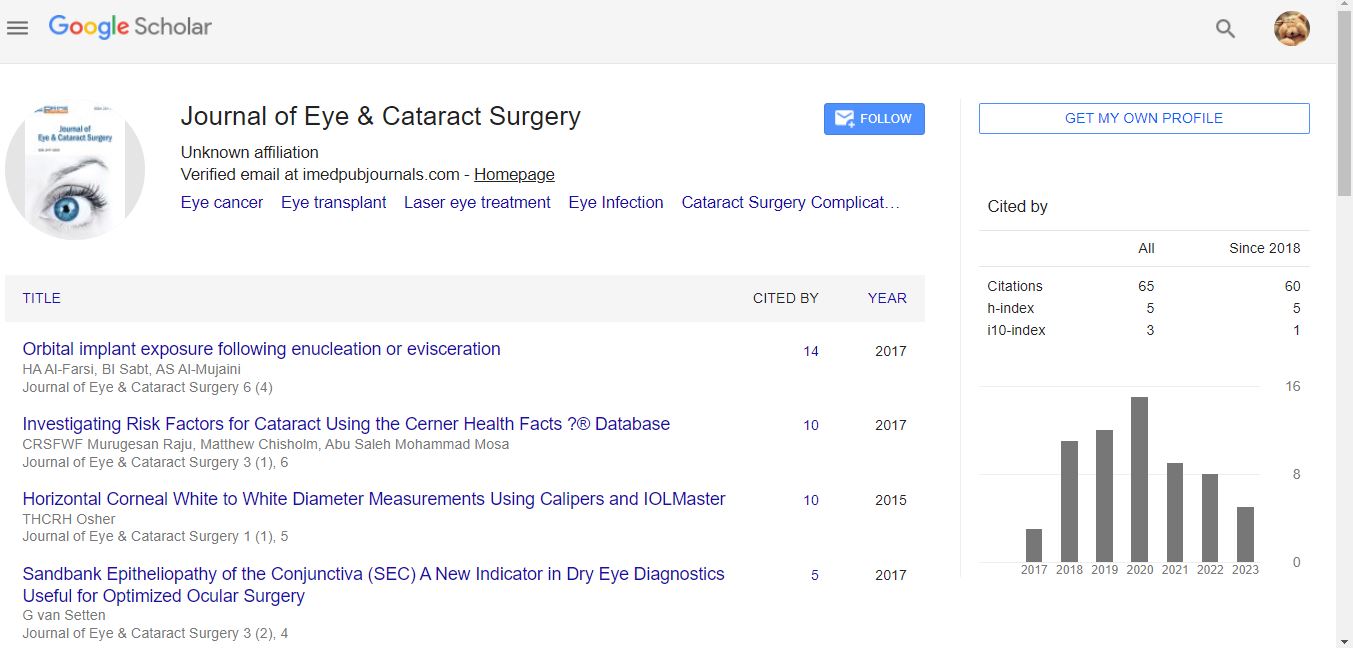Short Communication - (2024) Volume 10, Issue 4
Understanding Cataracts and the Role of Surgery in Vision Restoration
Clara Sophie*
Department of Ophthalmology, University of Naples Federico, Italy
*Correspondence:
Clara Sophie,
Department of Ophthalmology, University of Naples Federico,
Italy,
Email:
Received: 02-Dec-2024, Manuscript No. IPJECS-25-22555;
Editor assigned: 04-Dec-2024, Pre QC No. IPJECS-25-22555 (PQ);
Reviewed: 18-Dec-2024, QC No. IPJECS-25-22555;
Revised: 23-Dec-2024, Manuscript No. IPJECS-25-22555 (R);
Published:
30-Dec-2024, DOI: 10.36648/2471-8300.10.4.31
Introduction
Cataracts are one of the most common causes of vision impairment worldwide, primarily affecting older adults. The condition occurs when the natural lens of the eye becomes cloudy, leading to blurred vision, difficulty seeing at night, and sensitivity to light. Fortunately, cataract surgery is a highly effective and widely performed procedure that restores clear vision. This article provides an in-depth look at cataract surgery, its benefits, procedure, recovery, risks, and advancements in surgical techniques. A cataract forms when proteins in the eye's natural lens break down and clump together, creating a cloudy area. This cloudiness interferes with light passing through the lens, resulting in reduced vision. Cataracts develop gradually and can affect one or both eyes. Common causes include aging, prolonged exposure to UV rays, smoking, diabetes, eye injuries, and genetic predisposition. When these symptoms start interfering with daily activities such as reading, driving, or recognizing faces, cataract surgery becomes a viable option. Cataract surgery is a procedure that removes the clouded natural lens of the eye and replaces it with an artificial intraocular lens. It is an outpatient procedure, meaning patients can go home the same day [1,2]. The surgery is safe, effective, and has a high success rate in restoring clear vision.
Description
An ultrasound probe breaks up the cloudy lens into small fragments, which are then removed. Used for advanced cataracts that are too dense for phacoemulsification. Uses a laser to make precise incisions and soften the cataract. Before undergoing cataract surgery, patients must go through a preoperative evaluation, which includes. Measurements of the eye to determine the appropriate intraocular lens power. Instructions to stop certain medications that may affect the surgery. Use of antibiotic eye drops before surgery to prevent infections. The patient receives local anaesthesia in the form of eye drops or an injection. The surgeon removes the clouded lens using phacoemulsification or another technique. The incision heals naturally without the need for stitches. Recovery from cataract surgery is relatively quick, but proper care is crucial for optimal healing. Patients may experience mild discomfort, itching, or a gritty feeling in the eye. Avoid rubbing the eye, heavy lifting, and exposure to dust or bright light. Regular follow-up visits with the ophthalmologist are necessary to monitor healing. Prescribed antibiotic and anti-inflammatory eye drop help prevent infection and reduce inflammation. Modern advancements have significantly improved the safety and effectiveness of cataract surgery [3,4]. Multifocal and tori lenses allow patients to see clearly at multiple distances and correct astigmatism.
Conclusion
Provides precision in making corneal incisions and breaking up
the lens. Enhance vision quality for various distances, reducing
dependence on glasses. Cataract surgery is a transformative
procedure that restores vision and improves the quality of life
for millions of people. With modern techniques and advanced
intraocular lenses, the surgery is safer and more effective than
ever. For those experiencing vision impairment due to cataracts,
consulting an ophthalmologist about cataract surgery is the first
step toward clearer vision and a better life. In conclusion, cataract
surgery is a safe and effective procedure that can significantly
improve the quality of life for individuals affected by cataracts.
With advancements in surgical techniques and technology, the
procedure has become more precise, less invasive, and has a
faster recovery time than ever before.
Acknowledgement
None.
Conflict Of Interest
The author's declared that they have no conflict of interest.
References
- Fong CS, Mitchell P, Rochtchina E, Teber ET, Hong T, et al. (2013) Correction of visual impairment by cataract surgery and improved survival in older persons: The blue mountains eye study cohort. Ophthalmology. 120(9):1720-1727.
[Crossref] [Google Scholar] [PubMed]
- Tseng VL, Yu F, Lum F, Coleman AL (2016) Cataract surgery and mortality in the United States medicare population. Ophthalmology. 123(5):1019-1026.
[Crossref] [Google Scholar] [PubMed]
- Leske MC, Wu SY, Nemesure B, Li X, Hennis A, et al. (2000) Incidence and progression of lens opacities in the Barbados eye studies. Ophthalmology. 107(7):1267-1273.
[Crossref] [Google Scholar] [PubMed]
- McCarty CA, Mukesh BN, Dimitrov PN, Taylor HR (2003) Incidence and progression of cataract in the Melbourne visual impairment project. Am J Ophthalmol. 136(1):10-17.
[Crossref] [Google Scholar] [PubMed]
Citation: Sophie C (2024) Understanding Cataracts and the Role of Surgery in Vision Restoration. J Eye Cataract Surg. 10:31.
Copyright: © 2024 Sophie C. This is an open-access article distributed under the terms of the Creative Commons Attribution License, which permits unrestricted use, distribution, and reproduction in any medium, provided the original author and source are credited.

